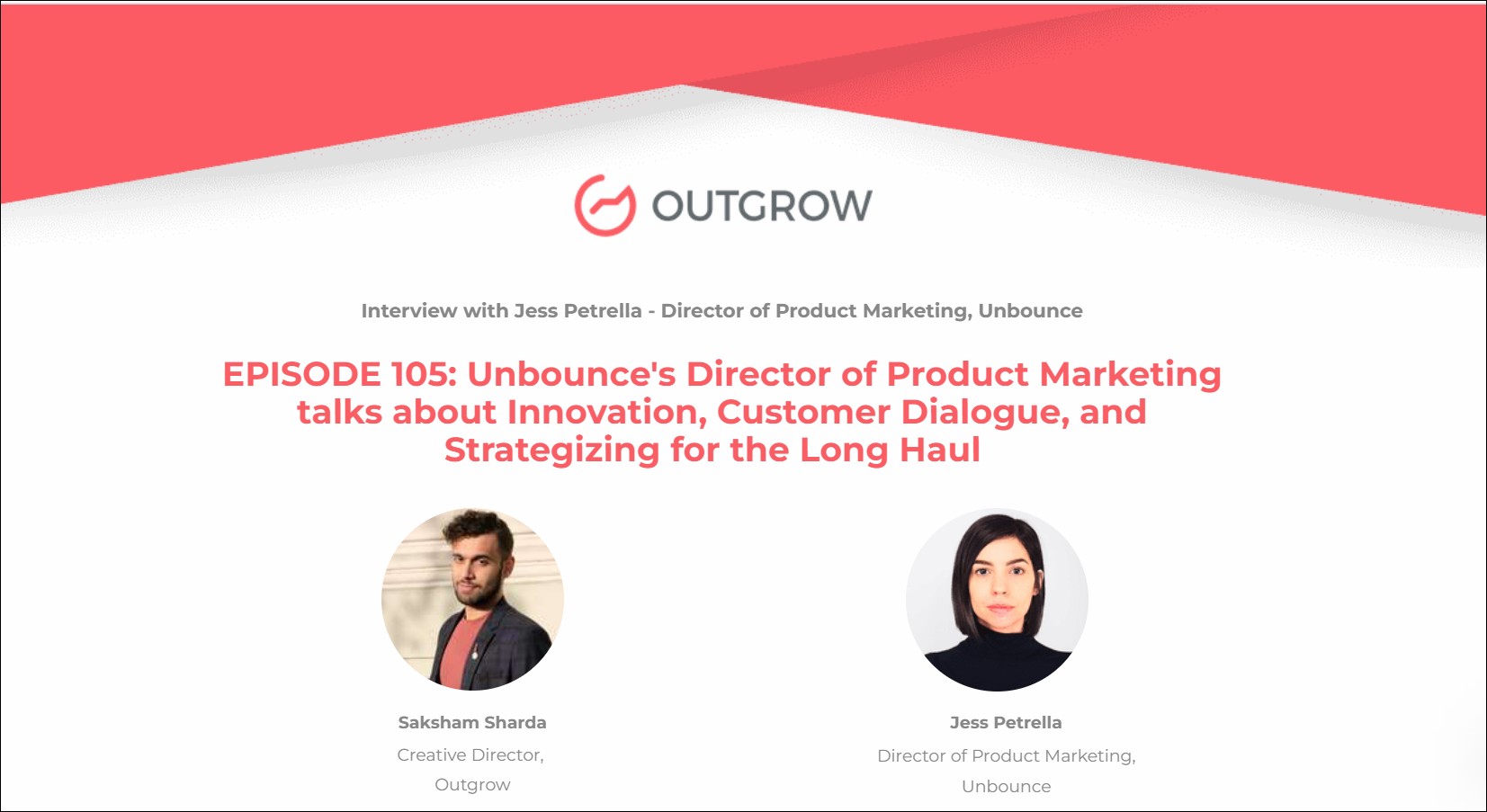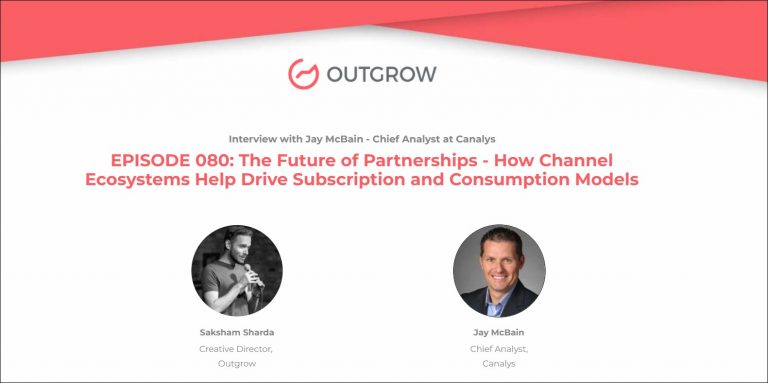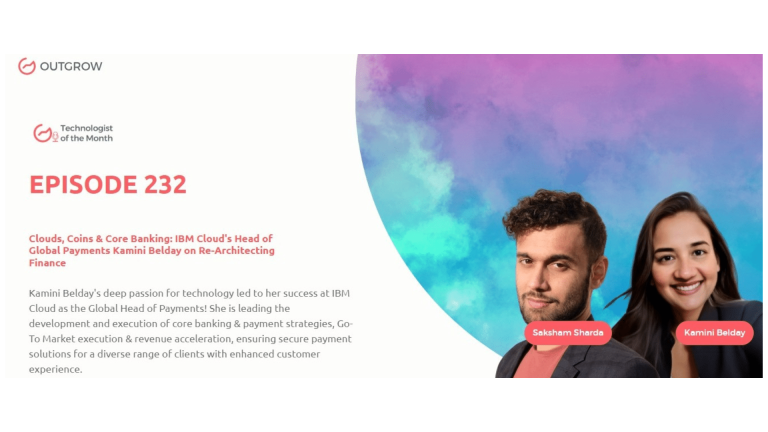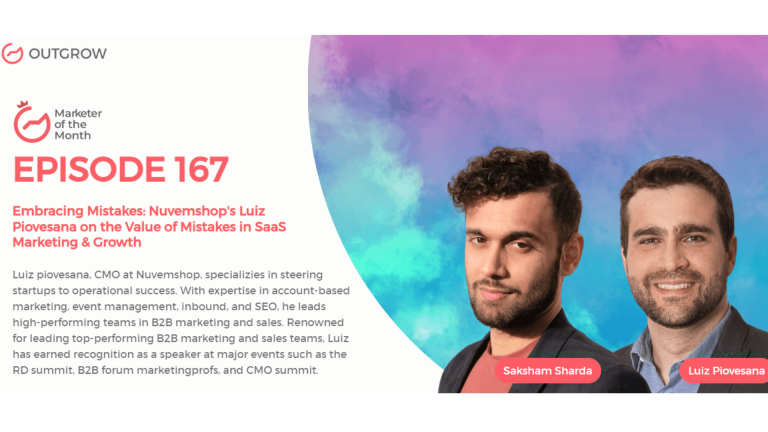EPISODE 105: Marketer of the Month Podcast with Jess Petrella
Table of Contents
Hey there! Welcome to the Marketer Of The Month blog!
We recently interviewed Jess Petrella for our monthly podcast – ‘Marketer of the Month’! We had some amazing insightful conversations with Jess and here’s what we discussed about –
1. Bridging the gap between product development and positioning
2. Marketing AI-based tools in different climates: benefits and challenges
3. Maintaining a solid foundation with purpose and values during a company’s evolution
4. Unbounce’s evolution and the role of AI and machine learning in its current products
5. Launching new products: common mistakes made by product marketers and ways to avoid them
6. Successful GTM strategies for innovative AI products: key elements
About our host:
Dr. Saksham Sharda is the Chief Information Officer at Outgrow.co He specializes in data collection, analysis, filtering, and transfer by the means of widgets and applets. Interactive, cultural, and trending widgets designed by him have been featured on TrendHunter, Alibaba, ProductHunt, New York Marketing Association, FactoryBerlin, Digimarcon Silicon Valley, and at The European Affiliate Summit.
About our guest:
Jess Petrella’s atypical journey to her current position began initially in in-house marketing teams, where she began freelancing as a graphic designer and marketer, and through this experience, she was able to identify the aspects of marketing that truly resonated with her, ultimately leading her to discover a passion for product marketing.
Unbounce’s Director of Product Marketing Talks About Innovation, Customer Dialogue, and Strategizing for the Long Haul
The Intro!
Saksham Sharda: Hi everyone. Welcome to another episode of Outgrows Market of the Month. I’m your host, Dr. Saksham Sharda. I’m the creative director at Outgrow.co. And for this month we are going to interview Jess Petrella who is the Director of Product Marketing at Unbounce. Thanks for joining us, Jess.
Jess Petrella: Wonderful. Thanks for having me.
Don’t have time to read? No problem, just watch the Podcast!
Or you can just listen to it on Spotify!
The Rapid Fire Round!
Saksham Sharda: So, Jess, we are going to start with a rapid-fire round just to break the ice. You get three passes, in case you don’t want to answer the question, you can just say pass. But try to keep your answers to one word or one sentence only. Okay?
Jess Petrella: Got it.
Saksham Sharda: At what age do you want to retire?
Jess Petrella: Never wanna retire. Yeah. Should be writing books at an older age if I’d like to.
Saksham Sharda: Okay. How long does it take you to get ready in the mornings?
Jess Petrella: 15 minutes.
Saksham Sharda: The most embarrassing moment of your life?
Jess Petrella: Can’t think of one quick, pass.
Saksham Sharda: Favorite color?
Jess Petrella: Black. Yeah. Void of color.
Saksham Sharda: What time of day are you most inspired?
Jess Petrella: First thing in the morning.
Saksham Sharda: How many hours of sleep do you need?
Jess Petrella: Not a lot. Six, seven. Maybe, that’s a lot.
Saksham Sharda: That’s decent actually. Fill in the blank: An upcoming marketing trend is _________.
Jess Petrella: Artificial Intelligence
Saksham Sharda: The city in which the best kiss of your life happened?
Jess Petrella: Ottawa.
Saksham Sharda: Pick one. Mark Zuckerberg or Jack Dorsey?
Jess Petrella: Pass.
Saksham Sharda: The biggest mistake of your career?
Jess Petrella: Too much pressure on myself early on.
Saksham Sharda: How do you relax?
Jess Petrella: Reading
Saksham Sharda: How many cups of coffee do you drink per day?
Jess Petrella: Zero, caffeine free.
Saksham Sharda: A habit of yours that you hate?
Jess Petrella: Slight perfectionism in most things.
Saksham Sharda: The most valuable skill you’ve learned in life?
Jess Petrella: One step at a time. One day at a time.
Saksham Sharda: And the last one is your favorite Netflix show?
Jess Petrella: I’m gonna pass. Can’t think off the top of my head too many.
The Big Questions!
Saksham Sharda: That was the end of the rapid-fire round. Now we can move on to the longer questions. The first one is, how does one bridge the gap between product development and positioning?
Jess Petrella: Yeah, great question. The two work in tandem as closely as possible. I say that because the product evolves from quarter to quarter, year to year. So should your positioning. The positioning’s not a fixed item on your checklist. It’s something that needs momentum. It needs evolution and it should always evolve alongside your product. Your product is what places you in a category. It’s really what validates how you are positioned and how you are understood. And I believe that you should evolve side by side. What relies on that as a really good working relationship between PM and PMM typically having that lockstep motion of understanding where we’re going and why is critical to revolving your positioning alongside your product roadmap.
Saksham Sharda: To what extent do you think maintaining a continuous and open dialogue with your prospective audience and customers can help this?
Jess Petrella: Yeah, that’s a constant, right? It also depends on the stage in which your organization or your product is. At Unbounce we are in between a very established builder and a new builder that is AI-based. It’s innovative and it’s part of a new emerging world of technology. And we’re still finding product market fit. So our customer feedback in that space is valuable in how we evolve it, but it’s all the more important to understand our market and where their expectations lie and where they want to see us go, and what new problems are arising that our tools can solve for them. And then that goes back to the positioning piece as well, where it’s critical for us to not just look inward in the organization in our customer base, but outward in the category, in the emerging categories in the market’s response to what we’re doing and what others are doing in our space. So there’s a balance there, right? You’re with an established product, your customers will always help you find that way. When you’re finding product market fit, looking outwards at the market, I find gives us that like, tactile, tangible understanding of how we evolve things like positioning and messaging and how we start to build our products so that we make it make sense for this new and emerging space.
Saksham Sharda: And to what extent do you think AI has gotta revolutionize SaaS itself? Cause you right now mentioned that Unbound is transitioning to an AI builder. How is the SaaS landscape gonna change in general?
Jess Petrella: Oh, it already has. Yeah. It’s really hard to take a step online or click online without seeing AI in the tools that we already use, right? So that for me was the first real indicator. You know, Unbound started to develop AI marketing tools over three years ago, right? And it felt very new to us, and we felt like we were pioneering forward on something that was in a really cold market to be quite frank. You know, marketers weren’t quite expecting AI. They didn’t know what questions to ask to evaluate it. So it was a little tricky to put it in front of them today. Fast forward to just the last three months, the market demand has increased tenfold since we first entered the space. We use that to our advantage because market demand and exposure to AI are crucial for selling the product we’re selling and communicating its value to our audience. But yeah, to answer your question, it’s, already everywhere in SaaS and quite quickly. So that’s our first indicator when I open a tool that I already use, and it’s starting to be part of that tooling that’s where I already see the early effects of it. In the long run, it becomes table stakes. That’s hard. Our thinking around it is that you should expect to use AI, an augmented AI part of your tooling no matter what, you know, task, you’re checking off your list or what use case you’re trying to achieve in that day or week. So there are two sorts of ways that organized SaaS organs are starting to utilize AI. One, it’s augmenting their existing core products. So it’s part of the typical workflow. They’re finding ways to make tasks quicker, easier, and better output or others are responding to that market demand and building a set of tools on top of their existing platform to bring in that curiosity from their target market and leverage the buzz that’s around it. Both are really smart tactics right now in SaaS. I believe that leveraging trends is the job of the SaaS marketer. But what’s going to have longevity is that embedded, integrated experience in your day-to-day workflow in the tools you’re already using. And we’re already starting to see that today, and I think that’s just gonna get stronger and stronger. You know, big tech has already like, latched onto it and there’s, you know, we call it like a popcorn opportunity where you can sit back and watch who’s gonna win that race. And then in organizations like ours, it is a way for us to achieve the mission that we’re going after in a way that is more advantageous for our target market.
Saksham Sharda: And what are some of the challenges and benefits of each of these approaches that you have mentioned?
Jess Petrella: Yeah, so I mean, integrating it into your SaaS product is advantageous because you already have a customer base who are you going down the path of your user experience. It’s advantageous for adoption. It’s advantageous for you to know, test, and validate certain ideas and concepts and see your customer base’s response to them. It’s a great way to provide net new value and increased value on top of what you already offer within your product offering. And I do think it has a little bit more longevity opportunity where if it’s part of your core offering, you’re able to continuously improve it, continuously innovate as the technology advances. But again, like I said, you know, building a set of tools to leverage market demand gain attention for your product, and offer something new and typically free to your target audience or your customer base is a great opportunity to, again, take advantage of the trend that’s ahead of us pre-validate before building and baking into your product. Getting those early response perspectives from early adopters. Yeah, and defining where AI fits into your core product offering, you don’t necessarily need to fully evolve or fully shift your focus. Sometimes it’s about just making what you already offer better. And AI is typically a way that SaaS organs right now are trying to do that.
Saksham Sharda: And so how does one go about fostering change like this or any kind in a particular organization anyway? Like, what would be the role of purpose and values in change?
Jess Petrella: Yeah. Well, it’s, you know, it’s not easy. Its product marketing’s focused at Unbounce right now. If I bring it back to our experience here Unbounce has been known as the leading landing page builder. And we, you know, had a hand in creating the category, leading it for several years. So as we started, you know, over the last few years integrating AI technology into our platform, AI copywriting, AI traffic automation, AI insights all to, you know, insight a better ROI on your spend as a marketer. We found that the real work to do there is to change market perception, right? You’re known for something for so many years over a decade and now you’re, you’re doing something altogether different. And we have a new builder versus our old classic builder that we’re still finding our way through a product-market fit with. And it’s something quite exciting. And we’ve had the opportunity to, you know, actually witness marketers transition from traditional marketing like our classic and old builder to AI marketing methods. That’s the thing that keeps us motivated because we see them do it right by the thousands. It’s not a new product. It’s not like we’re a new company just saying, “Hey, go use this”. We see the real-time transition from old to new and adopting new ways of doing things. So for product marketing at Unbounce, you know, we talked a little at the beginning bridging the gap between the roadmap and our product positioning. It is our primary focus now. And I believe that the way to do that well is, you know, to have the market come along with you. You can’t force news on the market. You can’t say, “Hey, we’re this, believe we’re this now”. It does, it is a bit of a long run, and it’s a slow-bake opportunity to sort of modify the way that the market perceives us and perceives our value. So the way that we do it is through a few things. As we talked a little bit about it, it’s a little bit less about customer feedback and more about market feedback. So for example, when we did our message market fit testing 12 months ago, it was radically different from what we hear in the market today. They’re more tuned into AI, they understand it. The questions they have are less about what and why and more, about how, and how does it work? How do you use the data? Do you pull audience data? Is it the same language model, large language models as everything else? And we’re able to respond to that. So the market is really what shows evolution, and they show us when they’re ready to understand the next phase. The second piece there is you know, in, we look outside of our existing category for direction for market readiness, for possibility and growth opportunities. So it’s less about, you know, first and best in your category. It’s how can we be different and sort of take learnings from, you know, adjacent categories. There’s also a lot of opportunity around our narrative design. It’s less about, you know, this world of like a concrete narrative that you run from like the beginning of the year to the end. It’s more about storytelling through some micro-narratives, depending on, you know, the speed in which our, technology evolves the stage in which we are evolving our positioning. So I find that helps us understand a little bit better. Also important to mention, there isn’t an innovator’s playbook when it comes to this new space of AI. So we sort of have to find our way through it and develop a blueprint that makes sense for us. And those are some of the ways that I find help us step through it. Internal storytelling is also incredibly important. You know, especially being in an organization that went from more of a traditional marketing mindset to a more innovative emerging tech mindset taking that time to bring your organization along with you on where the product is going, how it’s developing, how we are incrementally changing the way that the market perceives us is becoming super essential in how we approach things. So again, there isn’t a playbook for, you know, bringing innovative products to market. It depends on where your organization is and what work you have to do if you’re changing market perception or you’re breaking in as a breakthrough product. But the AI space is just so fast and so ever moving that I find our messaging and our positioning needs to sometimes change on a dime. So we have to stay very quick, very focused, and very plugged into what’s happening day to day. Because it’s an immensely quick space to be working within. It can cause a lot of anxiety if you don’t just like, stay focused and stay plugged into what’s happening.
Saksham Sharda: So in the past year, could you give us an example or a story of a particular campaign that you did or a market reperception that you had to do, or anything that would be interesting for a marketing audience?
Jess Petrella: Yeah. So interestingly, or we typically, we’ll do you know, yearly a benchmark report for conversion rate benchmarking. Or we’ll take on some enormous amount of research to be able to provide an enormous amount of value back to the market. Early last year we ran a research report around SMBs you know, response, how they’re using AI, what they think of it, what their general perspective is on it, what value are they getting at it, and if they’re, you know, experiencing it in the future. That research happened earlier in the year last year. If we take a look at it today and how we are centering our target market, how advanced their understanding of what this emerging tech is the research quickly becomes, you know, very outdated real quick, right? So when we’re running campaigns around that and we’re running campaigns going forward, it’s quite surprising how quickly things can become outdated. You know, like we have a joke internally here where someone will share a piece of news, and if it happened earlier in the morning and you don’t see it till later in the day, it’s like, that’s already old news, right? Because things were moving so quickly. And that is the same as how what we’ve seen in our day-to-day campaigns is, you know, if we don’t go quickly, if we don’t respond fast enough, if the topic isn’t topical you can get outdated quickly. So that’s one of those campaigns that we ran and put quite a lot behind at the time, it was impactful. But you know, as things move so quickly yeah, those, those stats and those research points change so fast. So that’s something we were trying to keep in mind is like, as we go through the space you know, very quick response is what’s going to sort of get us that impact in that breakthrough that we are looking for.
Saksham Sharda: And have there been any campaigns of the past that you’ve been able to recycle because the market changed again and all of a sudden, something that was of no use became useful or could be presented in contrast as useful?
Jess Petrella: Yeah. Well, we have an amazing content team. So you know, when we first started to break into the AI emerging market space we did build out a lot of primer content around AI marketing that kind of went stale over a little while because it was primer, it was very basic, it was very early. But we’re now finding an appetite starting up for that again. So we’re resurfacing that content which becomes a little bit more valuable today, where people are now newly interested in AI tech and how they can use it in their day-to-day marketing practice. So that’s a good example of how we are bringing things back that didn’t quite land the way we wanted them to because the market was a bit colder you know, a couple of years ago. It’s now evolved to be a very hot market. So in a hot market, you’re just, you know, response, response, response and that’s one of our efforts to do so.
Saksham Sharda: And to what extent do you feel overall AI is gonna have an impact on how we perceive landing pages themselves?
Jess Petrella: Yeah, so that is exactly what we are uncovering day-to-day, what we believed was the way two weeks ago changes as soon as GPT 4 hits the market, right? So it’s a large language MA model. It’s a more learned, large, large language model and it has new capabilities. So one of those capabilities, for example, is, you know, you can upload a sketch and then you can get an output for that. And we’ve seen Canva recently very quickly respond to that and bring it into their platform. Canva is 125 million users as part of their platform, right? So those users are now able to upload an image and get a bunch of outputs based on it depending on the campaign that you’re running or the assets you’re looking for. So that’s how quickly things can change, and that’s how quickly it can augment any type of asset creation. So that’s something we’re always keeping an eye on and keeping a close look at how we can bring that into our thinking. But you know, you’ll see software is typically about, you know, you start up your software, you do a ton of actions to get your output and it’s typically a starting point around, let’s say a template is a, a typical starting point for any sort of marketing asset that you’re creating. But the starting point now is more a prompt or a thought or perspective or an ask of what AI can do for you. So it’s more opinionated and it’s more yeah, perspective driven than it is choice-driven, right? So I’ve already determined what I’d like, here’s the input, and here’s the output, whereas this is something I can start with. I’ve gotta make all these changes for it to be, you know, what I want it to be. It’s a very different workflow. So I think there’s gonna be a lot of opportunity and we’ll shift greatly in how you interface with your software going forward.
Saksham Sharda: And how do you personally keep up with this rapid pace of change in the market itself? Like, do you feel overwhelmed sometimes, or how do you feel about that?
Jess Petrella: Yeah, you know, it’s something we do talk about. It’s you know, I’ve worked in innovative tech for quite a while, but this is something I’ve not experienced before, and truthfully, I don’t think anyone has, unless you’re going back to like the beginnings of the worldwide web coming to be it’s incredibly rapid. But I do find it very exciting because never has there been so much opportunity to end so much market demand so quickly, right? So if you can stay focused in your day-to-day you can harness the opportunities that are in front of you and be protective of your strategy while still having an innovation mindset I think it’s very advantageous, but it can be overwhelming at times, especially when there’s like five announcements on a Monday morning or especially when you see copycats come up as, as you start to innovate your tech competitors keeping up as much as they can with new releases of yours. It’s a lot of just like keeping up with the Joneses in that regard. And as the tech becomes more accessible, we’ll see that more and more, and it’s just to be expected. We’re a lot more focused on how can we do this in a meaningful way, and it’s less about those quick wins, and more about the long-term, what is the actual best application for AI in the day-to-day use of the marketer? So we’re very protective of our strategy in that way and quite focused on it. But there’s never been so much opportunity and so much market demand to leverage. There’s a bit of a downside to that though. I will also say, right? As I mentioned, message market fit can change on a dime. Your messaging is no longer just what you see on a website, but it’s just an everything because it’s never been so important to be in everything and have such a clear message coming through. After all, you are not just selling your product anymore. You’re selling your ideas and your perspectives and your point of view on how to leverage AI in our, in our example as a marketer. And then again, your direct competitors can uproot your differentiators very quickly because the technology is so it’s so accessible right now and it’s evolving so quickly and how, you know, through APIs and how accessible it’s to day-to-day SaaS platforms. So it’s really, it’s the long term and that product roadmap that goes into the year to years, five years, having that really clear understanding of what you’re building, why and who it’s for is really what’s gonna give companies the competitive edge right now while still, you know, taking advantage of those quick wins in that market demand, because never has there been a time where it was just so evident that that is the play right now.
Saksham Sharda: And so how do you all particularly deal with competition and copycats?
Jess Petrella: I mean, it’s one day at a time. I’m thinking that you know, all demand is good, demand all exposure is good exposure right now because it’s a such new technology, right? So to me, it doesn’t matter if our target market learned about AI copywriting, for example, through their notion you know, the page that they created that helps us prime them, right? And they come to us with more of an understanding of what to expect and how to use it. So to me, in this space right now, all demand is good demand all competitions good competition, it’s exposure, it’s accelerating the space and it’s making it a lot more exciting to be a part of. It is gonna come down to differentiators. So what is the differentiator in the AI space one thing that marketers would wanna understand is that every piece of AI that they interface with is typically based on the same large language model. So it’s based on the same machine-learning model. The difference there is when you’re evaluating this technology is it trained for you, right? So at Unbounce, our ML models are trained on our proprietary data. So we have billions of conversion data points that we train our model, essentially. It’s no longer a generalist. Our AI is a marketing specialist, right? So that’s the difference there in the simplest like terms, and then how do we use your data on top of that, you pull your audience data in when we’re automating your traffic, for example. And it becomes more specialized and more specific to the individual that is using it at the individual company, the individual marketer more so than the sort of high level for anyone for any use case AI that a lot of marketers are currently experiencing. So there will be a difference, but getting really niche and really specialized and very highly trained in fine-tuning we believe is the key differentiator there. We’re not just building AI, we’re building AI for marketers.
Saksham Sharda: Alright. So the last question for you is of a personal kind then, what would you be doing in your life, if not this right now?
Jess Petrella: Oh, that’s so hard to answer. I can’t imagine. This is my whole world right now. I probably find a way into AI somewhere or another. I do work on personal projects in the product marketing space as well. So I could probably see myself going down that path if I wasn’t doing this. But truthfully, I couldn’t think of anything that I prefer to be doing than this right now. It’s really rewarding to be able to make the change. It’s really rewarding to see the difference that this technology shift is making in our target markets world as well as our customers. It’s incredibly challenging, but I’m the type of product marketer that wants a big challenge to work through. So and I couldn’t ask for a better team at Unbounce to be doing that. So it’s a hard question because I’m sure there are many things that I could be doing, but this is just far too exciting to imagine anything other than this.
Saksham Sharda: So you’re not one of those people who’s gonna be a cabin in the woods.
Jess Petrella: Yeah, no, I love it. It keeps me going. That’s why I wake up so early and get started so quickly in the day.
Saksham Sharda: All right, well that was the last question. Thanks, everyone for joining us for this month’s episode of Outgrow’s Marketer of the Month. That was Jess Petrella, director of Product Marketing at Unbounce. Thanks for joining us, Jess.
Jess Petrella: Thank you so much.
Saksham Sharda: Check out their website for more details and we’ll see you next month once again with another market of the Month.
Let’s Conclude!
Saksham Sharda: All right, well that was the last question. Thanks, everyone for joining us for this month’s episode of Outgrow’s Marketer of the Month. That was Jess Petrella, director of Product Marketing at Unbounce. Thanks for joining us, Jess.
Jess Petrella: Thank you so much.
Saksham Sharda: Check out their website for more details and we’ll see you next month once again with another market of the Month.








